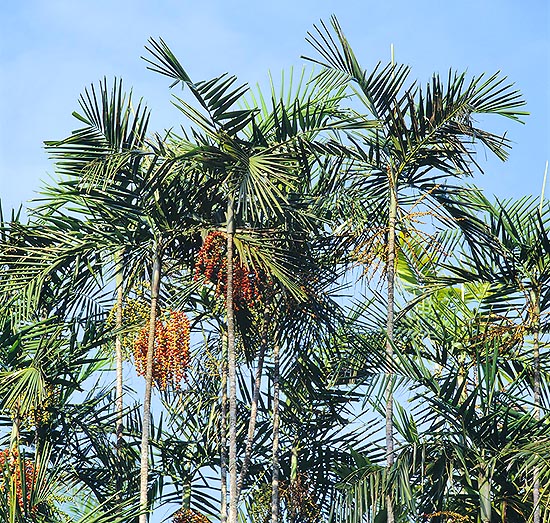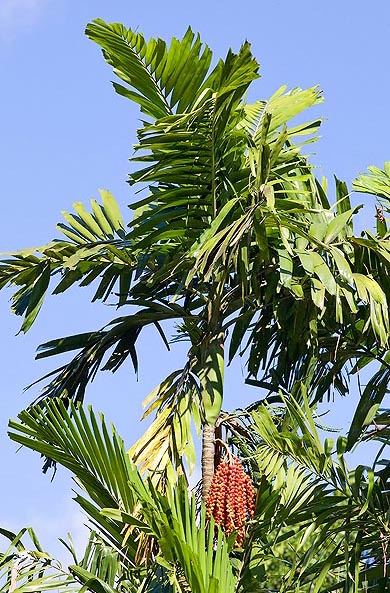Family : Arecaceae

Text © Pietro Puccio

English translation by Mario Beltramini

Ptychosperma macarthurii is a Queensland and New Guinea cespitose palm © Giuseppe Mazza
The Ptychosperma macarthurii (H. Wendl. ex H. J. Veitch) H. Wendl. ex Hook. f. (1884) is native to Australia (Queensland) and New Guinea, where it grows in the pluvial forests from the sea level up to about 400 metres of altitude.
The name of the genus comes from the Greek ‘ptyché’ = fold and ‘sperma’ = semen, with reference to the grooves present on the seed.
The name of the species was honoured to William MacArthur (1800-1882), politician, landowner and passionate Australian botanist.
It is commonly known as: “gray-cane palm”, “cluster palm”, “hurricane palm”, “Macarthur feather palm”, “Macarthur palm” (English); “palmeira-de-macarthurii (Portuguese); “McArthur Palme” (German); “palmier bambou”, “palmier de Mac Arthur” (French); “Palmera de MacArthur” (Spanish).
Cespitose palm, seldom with single trunk, with thin smooth stems of 6-8 cm of diameter, tall up to about 10 m, on which are visible the rings left by the fallen-off foliar bases.
The leaves of the Ptychosperma macarthurii are pinnate of 2 meters of length on a petiole long 30-50 cm, with the foliar base which wraps the trunk for a length of 40-70 cm. The leaflets are of a semi-glossy intense green colour, long 30-60 cm and wide up to 6 cm, obliquely cut and indented at the apex. The two terminal leaflets, shorter, are united at the base, assuming the characteristic form of a fish tail.

Numerous showy bright red ovoid fruits © Giuseppe Mazza
The inflorescence, under the leaves, is ramified and long about 50 cm. The flowers of cream-green colour are disposed in the typical triad (a female one in the midst of two male ones). The showy ovoid fruits, 12-16 mm of length, are numerous and of bright red colour when ripe.
The Ptychosperma macarthurii reproduces by seed which germinates in 2-3 months. The plant is widely cultivated for its ornamental characteristics in the tropical and subtropical countries.
Familiar in parks and gardens, it grows well in full sun or partial shade, and is frequent in the hotels alleys, where it adds an exotic touch for the tourists better enjoyment.
It loves well drained and rich in humus soils, well watered, even if it stands, when adult, to short period of drought.
Its cultivation in the temperate-warm climates can be tried marginally in open air, seen that, when adult, in well drained soils, can resist, for very short time, to temperatures around the 0 °C.
The Ptychosperma macarthurii has a moderate utilization as pot plant in the indoors decoration, and can give good satisfactions in luminous spaces with some daily hours of sun.
Synonyms: Kentia macarthurii H.Wendl. ex H.J.Veitch (1879); Saguaster macarthurii (H.Wendl. ex H.J.Veitch) Kuntze, (1891); Actinophloeus macarthurii (H.Wendl. ex H.J.Veitch) Becc. ex Raderm. (1925); Actinophloeus bleeseri Burret, (1928); Carpentaria bleeseri (Burret) Burret, (1928); Ptychosperma bleeseri Burret, (1928); Actinophloeus hospitus Burret, (1931); Ptychosperma julianettii Becc. (1934); Ptychosperma hospitum (Burret) Burret, (1935); Actinophloeus macarthurii var. hospitus (Burret) L.H.Bailey ex D.Fairchild, (1947).
→ For general notions about ARECACEAE please click here.
